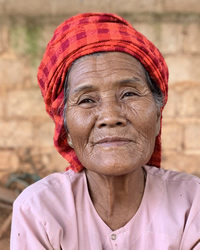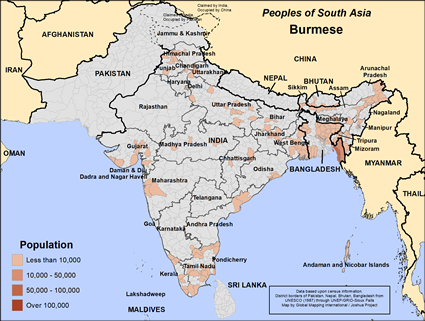Burmese civilization probably goes back 3500 years in the Irawaddy Valley, where people were using bronze tools, growing rice and raising livestock. By the 500s, they had adopted Buddhism, which was a turning point for their culture. In the 1000s, the Bama people arrived from the hills of Tibet, and King Anawrahta unified Burma as a nation in 1057. Other kings followed who established Buddhist pagodas, monasteries, libraries, and even places of higher learning. They could control their water supply in such a way that they increased their rice harvests. This civilization waned in the 1300s partly because they gave too much of their resources to the Buddhist monks. This left them more vulnerable to the ravishes of the Mongol Empire and the Tatars. It took another 200 years before a new, expansionist Burmese leader arose, Bayinnaung. He unified Burma for a short time through conquest. After his death, sections of his empire broke away. The Burmese expanded in the early 1800s, but the Chinese stopped them. Soon the British Empire made Burma a province of India for a season.
Today, the Burmese are the political, economic and religious leaders of Myanmar. Myanmar has had a long history of coups, wars and rebellions. Ethnic divisions and political unrest have been common since the first Burmese kingdom in the eleventh century. Today, the Burmese military maintains forcible control over the ethnic groups who want equal power in the government and in commerce. The military promises a ceasefire, but they attack at the slightest note of rebellion. The ethnic groups of Myanmar, including the Burmese majority, have lived in a constant state of instability and fear. Thousands have fled to nearby Asian countries like Cambodia, China, Sri Lanka, India, and especially Bangladesh.
Though most refugees from Myanmar in India are from the ethnic Chin people, there are also some Burmese as well. The Burmese in India are usually either in Delhi or India's northeastern states.
Ethnic divisions and political unrest have been common since the first Burmese kingdom in the eleventh century. Many Burmese eventually fled to Bangladesh, Thailand, and India in hopes of finding a more peaceful climate. Unfortunately, India is reaching their limit as to the number of refugees they can take in. In addition, India has had several problems because of racial prejudice. The Burmese stand out with their East Asian features, and India does not offer legal protection. Women are sometimes harassed, and Indian government officials can deport Burmese individuals.
The fertile valleys support intense rice cultivation. Industrial development is limited, however, because of East India's isolation from the rest of India, their poor transportation system, and small local markets. Therefore, the Burmese are limited to farming for survival.
The Burmese ideally grow rice in irrigated fields; however, they also resort to "slash and burn" cultivation. In this process, they first clear the plots by burning off the vegetation. Then they grow crops on it for one or two years before moving to new territory.
The Burmese do not recognize clans or lineages. Marriages are monogamous (one husband, one wife), and are rarely arranged by the parents. Newlyweds live with the bride's parents for the first two or three years after marriage. Then they will set up their own independent households.
The Burmese live in villages that are clustered among trees, or along roads or riverbanks. There are many types of houses in Burmese villages. The wealthier people often live in sturdy, mahogany homes that are raised off the ground and have plank floors and tile roofs. Those with lower incomes may live in thatched roof, bamboo houses that have dirt floors. All activities take place on the dirt floors, including eating and sleeping. Therefore, it is extremely impolite to enter a Burmese house wearing shoes.
The single most important social institution in the village is the temple. It symbolizes unity among the villagers and provides a wide variety of activities for the people.
The Burmese are predominantly Buddhists. The traditional goal in Buddhism is to seek the middle path to Nirvana, or ultimate peace. They believe that death is not a threat to one who has done good deeds. Instead, it is simply a "passing" from one life to another. They believe that those with less merit are reborn as demons, ghosts, animals, or inhabitants of hell.
Though the Burmese are predominantly Buddhist, they have mingled many animistic practices (based on the belief that non-human objects have spirits) with Buddhism. Their animistic beliefs center on inherently evil spirits called nats. Sadly, they spend their lives trying to appease the nats so that they will be protected from any other evil spirits that may seek to harm them. All of their homes have altars for the spirits, as well as a statue of Buddha.
The Burmese left their homeland in search of peace. Unfortunately, they are not finding peace in India. They need loving Christ followers who will introduce them to the Prince of Peace, Jesus Christ. Fervent prayer and increased evangelism efforts are the keys to seeing them reached with the gospel.
Pray that the sheer wonder of knowing Jesus and the impact he has on lives will become apparent to the Burmese in India.
Pray the hearts of the Burmese people would be stirred by a sovereign work of the Holy Spirit readying them for the time when they hear the gospel message being shared with them.
Pray they will experience dreams and visions of Jesus leading them into a saving relationship with him.
Pray for an unstoppable movement to Christ among the Burmese people in India.
Scripture Prayers for the Burmese in India.
| Profile Source: Joshua Project |












